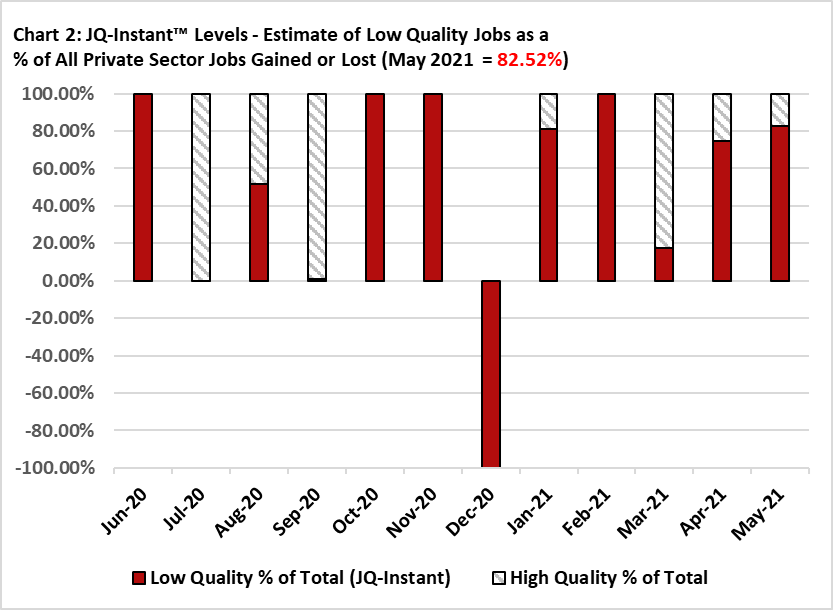
Good Jobs Day morning! Hopefully we will see a renewed acceleration in the restoration of jobs during May. But after we dissect the data at 8:30am EDT. the remaining question will be which sectors still have not returned to prepandemic employment levels?
Answer: Mostly low income
Answer: Mostly low income
We know that the re-employment gap is mostly in the low income sectors (below) because there are many workers receiving unemployment benefits exceeding incomes from their old jobs.
What we don't know is whether all their old jobs are really still there!
nytimes.com/2021/06/01/opi…
What we don't know is whether all their old jobs are really still there!
nytimes.com/2021/06/01/opi…
With the above as prologue, stay tuned for the data in 5 minutes....
#BLS reporting May Non-farm Payrolls increasing by 559,000 and the U-3 unemployment rate falling to 5.8%.
Here come the details and, shortly, the @jobqualityindex and #JQInstant readouts.
Here come the details and, shortly, the @jobqualityindex and #JQInstant readouts.
NFP was disappointing and further hurt by the downward revision to the very disappointing prior month. There is no question that what I wrote earlier this week is a big factor. The incomes offered are not attracting people off of unemployment benefits:
nytimes.com/2021/06/01/opi…
nytimes.com/2021/06/01/opi…
The telling point is that the projected DECLINE in average hourly earnings did not materialize (it rose 0.5%) because the composition of rehiring not drawing back the low income workers.
The decline in the labor force participation rate by 1/10th of a percent is disappointing too, but I read it as folks falling off extended benefits and not rushing out to look for new jobs right away because what is out there is paying very little. They will eventually need a job
While the traditional low-wage/low-hours sectors pick up jobs - they are nowhere near the volume necessary to restore headcount to pre-pandemic levels. Big concern, however it that retail FELL by 6K. Are the jobs just not out there because so many stores have closed? Very likely.
The rest of the traditional low-wage/low-hours sectors accounted for most of the net job growth:
Leisure and Hospitality: 292K
Healthcare and Social Assistance: 46K
Administration and Waste Services: 18K
Leisure and Hospitality: 292K
Healthcare and Social Assistance: 46K
Administration and Waste Services: 18K
Important to note in the above regard that PRIVATE SECTOR payrolls only increased by 492K or the total NFP of 559K - the rest being, of course, government employment. So those three low income sectors were 356K of 492K in private jobs formed in May.
Another disturbing data point is that the labor force itself declined by 53K. Very unusual during a "booming recovery" (scare quotes intended). Jobs on offer are not drawing in even those workers who have timed out of their unemployment benefits or just stopped looking.
And here's the @jobqualityindex's #JQInstant graph showing that 82.52% of the private sector jobs formed in May were in Low-wage/Low-hours sectors. Not unexpected as a percentage, but as discussed above, not enough takers of these low income jobs (or too many lost businesses?). 

And this data tells the a big story:
Leisure and hospitality hourly wages rise a huge 1.2% M/M but hours worked FALL to 25.1 from 25.3. Pretty odd for employers complaining about no available workers. So weekly incomes rise from a pathetic $396.70 to a nearly unchanged $398.34!
Leisure and hospitality hourly wages rise a huge 1.2% M/M but hours worked FALL to 25.1 from 25.3. Pretty odd for employers complaining about no available workers. So weekly incomes rise from a pathetic $396.70 to a nearly unchanged $398.34!
And now we have the @jobqualityindex through April (runs with a 1 month lag) which fell -0.42% to 81.49. The index should continue to fall (albeit SLOWLY given today's data) as low income jobs eventually return to the mix. (Click to open the graph to see recent data) 

This month's full @jobqualityindex report - with updates to today's Employment Situation Data - is now out, here:
bit.ly/JQIMay2021
bit.ly/JQIMay2021
• • •
Missing some Tweet in this thread? You can try to
force a refresh



